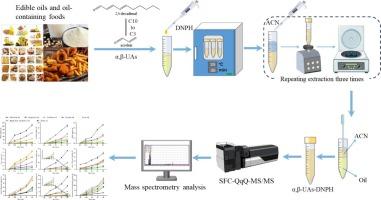SFC-ESI-QqQ-MS/MS同时分析食用油和含油食品中丙二醛和典型α、β-不饱和醛的方法的建立、验证及应用
IF 9.8
1区 农林科学
Q1 CHEMISTRY, APPLIED
引用次数: 0
摘要
建立了同时定量食用油和含油食品中丙二醛(MDA)和7种α,β-不饱和醛(α,β-UAs)的超临界流体色谱-串联质谱(SFC-ESI-QqQ-MS/MS)方法。结合DNPH衍生化和一步提取,该方法具有良好的线性度(R2≥0.9995),快速分析(16 min/个样品),加样回收率(85.84 ~ 106.71%),精密度(RSD < 7.86%), LOD/LOQ为0.05 ~ 0.60/0.15 ~ 1.80 μg/kg。随后,该技术被应用于监测八种食用油在加热过程中MDA和α,β-UAs的形成,揭示了脂肪酸组成和加热时间对浓度的依赖性。利用该方法测定了中国常见的29种含油食品中丙二醛(MDA)和7 α,β-UAs的含量,浓度范围分别为2.65 ~ 326.79 μg/kg和15.67 ~ 770.71 μg/kg。作为第一个基于sfc的全面醛谱分析方法,该方法可以精确监测脂质氧化途径,并支持食品工业的质量控制创新。本文章由计算机程序翻译,如有差异,请以英文原文为准。

Development, validation and application of an SFC-ESI-QqQ-MS/MS method for simultaneous analysis of malondialdehyde and typical α,β-unsaturated aldehydes in edible oils and oil-containing foods
A novel supercritical fluid chromatography coupled with tandem mass spectrometry (SFC-ESI-QqQ-MS/MS) method was developed for simultaneous quantification of malondialdehyde (MDA) and seven α,β-unsaturated aldehydes (α,β-UAs) in edible oils and oil-containing foods. Combining DNPH derivatization with one-step extraction, the method achieved exceptional performance: linearity (R2 ≥ 0.9995), rapid analysis (16 min/sample), recoveries (85.84–106.71 %), and precision (RSD < 7.86 %), with LOD/LOQ at 0.05–0.60/0.15–1.80 μg/kg. This validated technique was subsequently applied to monitor the formation of MDA and α,β-UAs during the heating of eight edible oils, revealing concentration dependencies on fatty acid composition and heating duration. Furthermore, the levels of MDA and seven α,β-UAs in 29 oil-containing foods commonly consumed in China were determined using the developed method, with concentrations ranging from 2.65 to 326.79 μg/kg and 15.67–770.71 μg/kg, respectively. As the first SFC-based approach for comprehensive aldehyde profiling, this method enables precise monitoring of lipid oxidation pathways and supports quality control innovations in the food industry.
求助全文
通过发布文献求助,成功后即可免费获取论文全文。
去求助
来源期刊

Food Chemistry
工程技术-食品科技
CiteScore
16.30
自引率
10.20%
发文量
3130
审稿时长
122 days
期刊介绍:
Food Chemistry publishes original research papers dealing with the advancement of the chemistry and biochemistry of foods or the analytical methods/ approach used. All papers should focus on the novelty of the research carried out.
 求助内容:
求助内容: 应助结果提醒方式:
应助结果提醒方式:


